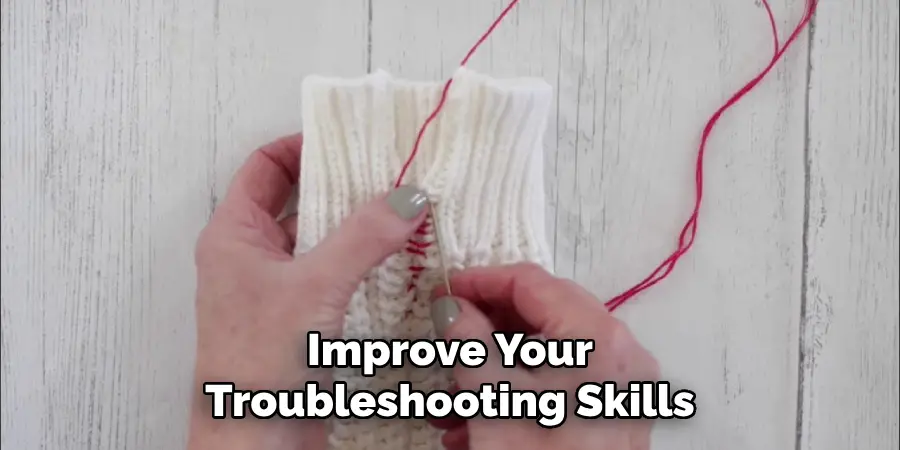Are you having difficulty getting your project done because of one pesky “snag”? Feel like it’s taking forever to fix and you don’t know what to do? Don’t get too overwhelmed – we’ve all been there. Fortunately, fixing a snag is easier than you might think.

Here in this blog post on how to fix snag, we’ll be discussing some tips on how to quickly and effectively troubleshoot and resolve the issues that arise. From learning about common problems with snags to understanding how to address those problems, we have the answers for you!
So sit back, relax, and let us show you that tackling even the toughest snags doesn’t have to take up so much of your time.
Needed Materials
Before we dive into the solutions, it’s important to note that some basic materials will be needed in order to fix snags. These include:
- A Computer or Device With Internet Access
- Relevant Software for Your Project (E.g., Coding Tools, Design Programs)
- Basic Troubleshooting Knowledge and Problem-solving Skills
- Patience and Determination
11 Step-by-step Guidelines on How to Fix Snag
Step 1: Identify the Problem
The first step to solving any problem is understanding what the problem actually is. Take some time to identify the specific snag and what is causing it. Is it a coding error? A design issue? Knowing the root cause will help narrow down potential solutions. It’s also important to keep an open mind and consider all possibilities.

Step 2: Research and Gather Information
Once you have identified the problem, it’s time to do some research. Look for similar issues online or consult with colleagues for their insights. It’s always helpful to gather as much information as possible before attempting to fix a snag. This will save you time and prevent potential mistakes. You may also find that someone else has already found a solution!
Step 3: Regroup and Take a Break
Sometimes, stepping away from the problem for a bit can help you come back with a fresh perspective. Taking breaks is important when trying to fix any issue, as it allows your brain to rest and recharge. Don’t be afraid to take some time off and come back to the problem later. This can often lead to a breakthrough in finding a solution.
Step 4: Check for Updates or Patches
If the snag is related to software, check for updates or patches that may have been released. Sometimes, these updates contain fixes for known issues. Make sure to always keep your software up-to-date to prevent future snags.
It’s also a good idea to check for compatibility issues if you have recently made any changes to your system. But be careful not to make too many changes while trying to fix the snag, as this can further complicate the issue.
Step 5: Try Basic Troubleshooting Techniques
If the above steps don’t solve the problem, it’s time to try some basic troubleshooting techniques. This includes restarting your computer or device, clearing cache and cookies and checking for internet connectivity issues, If the snag is related to hardware, try unplugging and replugging in devices. These simple steps can often fix common snags. But if they don’t work, it’s time to move on to more advanced solutions.

Step 6: Roll Back Changes
If the snag occurred after making changes to your project, try rolling back those changes. This is especially helpful if you have recently added new code or made updates to design elements. Sometimes, a small error in these changes can cause snags. Rolling back to a previous version can help identify the root cause and allow you to fix it.
Step 7: Consult Online Forums or Communities
If you’re still struggling, don’t be afraid to seek help from online communities or forums. There are many knowledgeable individuals who may have encountered similar snags and can offer valuable insights. Be specific when asking for help and provide as much information as possible about the issue. You may just find a solution you never even thought of.
Step 8: Consider Hiring a Professional
If all else fails, it may be time to consider hiring a professional. This could be a tech support specialist or an expert in your field. While it may come at a cost, having someone with expertise and experience can save you time and frustration in the long run. It’s always a good idea to have a professional on hand for particularly challenging snags.
Step 9: Document Your Steps
If you do end up finding a solution, make sure to document the steps you took. This will not only help you in the future if a similar snag arises, but it can also be helpful for others who may encounter the same issue. Sharing knowledge and solutions can help make troubleshooting easier for everyone. It’s always a good idea to give back and contribute to the community.
Step 10: Celebrate Your Success
After all the time and effort spent on fixing the snag, don’t forget to celebrate your success! It may have been a challenging journey, but you made it through and learned new skills along the way. Take some time to reflect on what you learned and give yourself a pat on the back. This positive mindset will help you tackle any snags that come your way in the future.
Step 11: Learn from Your Experience
Finally, it’s important to learn from your experience. Use this as an opportunity to improve your troubleshooting skills and prevent similar snags from occurring in the future. Reflect on what worked and what didn’t, and make changes to your approach if needed.

With every snag you fix, you’ll become more confident in your abilities and better equipped to handle any challenge that comes your way. So next time a snag occurs, remember these steps and you’ll be able to fix it like a pro! Remember, don’t give up and always keep learning.
Following these guidelines on how to fix snag will not only help you fix snags, but also improve your problem-solving skills and make you a more efficient and resourceful individual in the tech world. So don’t let snags discourage you, embrace them as opportunities to learn and grow! Now go forth with confidence and tackle any snag that comes your way.
Frequently Asked Questions
Q1: What if I Can’t Identify the Root Cause of the Snag?
A1: If you are having trouble identifying the root cause, try doing more research or consulting with others for their insights. It’s important to have a clear understanding of the problem before attempting to fix it. If all else fails, consider seeking help from a professional.
Q2: How Do I Prevent Snags from Occurring in the Future?
A2: To prevent future snags, make sure to keep your software and systems up-to-date, regularly back up your work, and always test any changes before implementing them. It’s also important to continuously improve your troubleshooting skills and stay informed about potential issues or bugs.
Q3: What if I Don’t Have Time to Fix the Snag Right Away?
A3: If you’re short on time, it’s important to prioritize the snag based on its impact and urgency. If it can wait, take a break and come back to it when you have more time. If it’s urgent, try to find a temporary workaround until you can fully address the issue.
Don’t let snags overwhelm you and always remember to take breaks when needed. So don’t let snags discourage you, embrace them as opportunities to learn and grow! Now go forth with confidence and tackle any snag that comes your way.
Q4: Can I Share My Snag-Fixing Experience with Others?
A4: Absolutely! Sharing your experience and solutions can help others facing similar snags. It’s always a good idea to give back to the community and contribute to the collective knowledge.
You may even receive valuable feedback or suggestions from others, helping you improve your approach in the future. Remember, don’t give up and always keep learning. So next time a snag occurs, remember these steps and you’ll be able to fix it like a pro!
Conclusion
To conclude, whether the project was big or small, learning how to fix a snag is a helpful skill that will come in handy time and time again. Start by thoroughly examining the project to understand where the snag might be and why it happened. Then troubleshoot the issue step-by-step while minding safety protocols and using tools the right way.
Don’t hastily move on without getting to the root of the problem – otherwise, you’ll end up with worse snags down the line. If all else fails, don’t be afraid to reach out for help from experts or those with experience. Take care and best of luck! Thanks for reading this article on how to fix snag.

